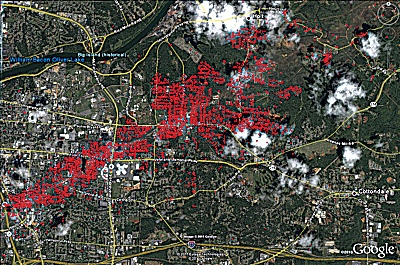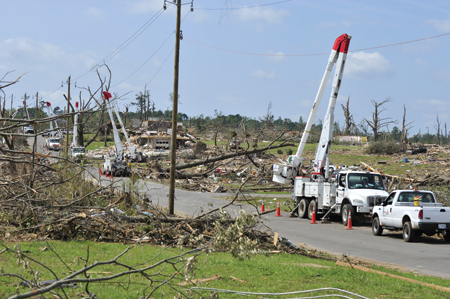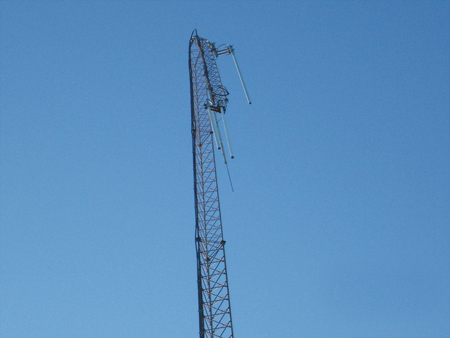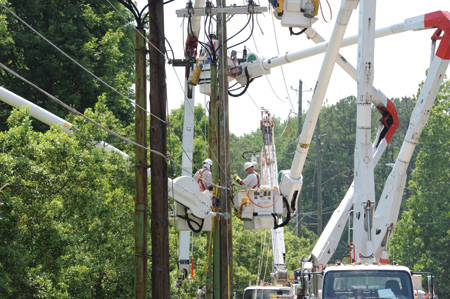On April 27, 2011, Alabama Power Company — the Birmingham-headquartered Alabama operating company of the Southern Company — experienced one of the most devastating and deadly natural disasters in US history. Damage caused by a string of tornadoes (Cover) striking Tuscaloosa, Alabama and the surrounding area dealt a severe blow to both the communities in the region as well as Alabama Power Company, with more than 400,000 customers without power at the storm’s peak. In addition, nearly 4200 poles, and as many as 400 transmission system structures were either damaged or destroyed. Besides the physical damage, a total of 243 people lost their lives — a loss that can never be restored. Yet just eight days after the storms passed, most of the affected area was up and running again, thanks to the influx of emergency workers; federal, state and local authorities; residents of Tuscaloosa and the surrounding communities; volunteers from far and wide, including those from other utilities across the country; and of course, the dedicated employees of Alabama Power Company. But there was another ingredient in this rapid recovery — an often unsung ‘hero’ that works 24/7, takes no breaks, sick days, holidays or vacations, and that is always ready for the worst — whenever and wherever it may occur: Alabama Power Company’s automation systems and the associated hardware and software assets. In the next few pages, you’ll learn how automation of various types and forms helped Alabama Power to survive the storm and restore power to homes and businesses in record time. Moreover, you’ll see how interaction and interoperability across systems helped to multiply the individual benefits and operational capabilities of each. In the second part of the article, you’ll have a chance to see how the integrity of Alabama’s Advanced Metering Infrastructure and the logistics associated with their Smart Meter preparation and roll-out helped to prepare the utility for the unexpected and unprecedented act of nature that nearly wiped out an entire region — truly, a lesson in Automation, Dedication & Determination! — Ed.
Alabama Power Company had been preparing for severe weather to hit the state long before the morning of April 27, 2011. By daybreak, repair crews were already working to restore power to about 270,000 customers affected by a line of storms that had passed through overnight. With predictions of a dangerous, tornado-laden storm heading its way, bucket trucks and crews from utilities as far as Illinois headed to the Heart of Dixie in anticipation of more damage to come. Despite the helping hands, customers were advised to prepare themselves for extended outages.
Alabama Power Company parent, Southern Company, had begun laying the groundwork for effective response management and system modernization well before the storm clouds formed when it embarked on an initiative to have its utility subsidiaries integrate their current outage management systems (OMS) with advanced meter infrastructure (AMI) systems. By fall 2010, Alabama Power had successfully merged a proprietary OMS in service for years with an open-standards based, multi-application, fixed-base, two-way wireless communications network from Sensus Metering Systems to gain a number of key benefits, including real-time situational analysis and grid stabilization.
Storm events are common for any utility, and Alabama Power’s recovery response protocol proved highly effective. The ability to collect data from smart meters and deliver it over the AMI system added a new dimension to utility operations because the information could be used to enhance our outage estimation systems. The April 27th storm that ripped through Tuscaloosa County and surrounding areas was anything but typical. Indeed, before the skies cleared it would become the most powerful, destructive event in recorded history, damaging or destroying countless utility assets. The tower-based communication network, however, remained largely intact and provided valuable information that helped those responsible for the utility’s restoration efforts.
Extending OMS Limits
Alabama Power Company’s OMS is a valuable tool that performed well the day of the storm, alerting technicians to the number of customers without power. Here’s a brief summary of how the system works… If three meters under a common switch indicate an outage, the system is smart enough to know every meter under that switch is out. As more incidents are added, the system analyzes the outage data and generates an outage-prediction location. It also organizes and analyzes recorded incidents to predict whether a string of outages are connected to a larger outage at a substation, fuse or breaker.
Keyhole Markup Language for Outage Maps
In cases where there are power outages due to major weather events or natural disasters, the traditional functionality of an OMS may not be adequate to manage the restoration. That’s when utilities will turn to Google maps for continuous updates, where reports coming directly from responders can be visually represented internally or to customer sites.
The red dots on the Google map image below indicate power outages in Tuscaloosa, Alabama, on April 27 after a tornado swept through.

Power Outages in Tornado Aftermath on April 27, 2011 in Tuscaloosa, Alabama
This geospatial imaging is based on Keyhole Markup Language (KML), a simple but powerful file format for displaying data in an earth browser, such as Google Earth or Google Maps. It was originally developed by Keyhole, Inc., which later became a part of Google in 2004. The word “keyhole” originated with a U.S. military reconnaissance satellite program developed in the 1970s.
KML uses XML-based set of standards for gathering, storing, and transmitting data for two-dimensional and three-dimensional digital maps. The KML standard was first used to power Google Earth, but other web-based map services have adopted it as well. KML has also become one of the standard map storage and transfer protocols for a wide range of GPS devices.
KML uses the three-dimensional geographic reference system of longitude, latitude, and altitude to describe a basic point of view in space over or on the surface of the Earth, then adds more specific control over that view with heading, tilt, and roll factors.
Particularly useful to utilities is that KML offers the ability to add text information, graphic overlays, 3-D polygons, paths, icons and add embedded files (images or auditory) to enhance the experience of the geobrowser applications.
But while an OMS can estimate where service is out, it can’t necessarily reflect where service is back on – or more importantly – what locations could actually take power. That’s where the integration with AMI comes in.
For example, let’s say there are 500 residences connected to one switch. Alabama Power can know the switch is open either through the SCADA system indicating the switch open or by pinging the affected meters. But if the switch is closed, the utility can’t know the status of those 500 customers. Following the storm, so many structures were damaged or destroyed from the tornadoes, restoring service wasn’t immediately possible in some areas. Available meter data was able to provide enough clues to give us the information about individual premises that the legacy OMS couldn’t.

Smart meters send real-time alerts, the so-called “last gasp” to signal outages in many cases, sooner than customers can call the utility to report the outage. With these messages, the OMS can specify critical loads; typically hospitals, fire stations or traffic signals for priority restoration.
In the storm’s aftermath, the question was, “Can a given premises take power?” With the AMI system integration to OMS, you answer this question with another question, “Can I or can’t I talk to the meter?” Alabama Power began generating reports listing meters that couldn’t be reached with the correlating data fed into a KML (Keyhole Mark-Up Language) generator for displaying outages geographically in a Google map.
These reports were updated throughout the restoration process for storm responders, but the information was also used by marketing personnel to confer directly with large customers as well as accounting staff to track service orders necessary for disconnecting power at structures wiped away by the storm. Communicators used the data for regular news updates that kept the media and customers informed on the restoration progress.
Network Stays Intact
Durability in a storm situation was a significant, but not deciding factor in selecting an AMI technology several years ago, but no one at Alabama Power could have anticipated the magnitude of destruction from the storm that hit the southeast that day in April. Notably, tornadoes were originally seen as less of a threat than hurricanes.
An important consideration in selecting the fixed-based, point-to-multipoint AMI solution was that it required far less infrastructure, reducing exposure to damage. Thousands of miles of transmission and distribution lines and structures were lost in the storm, which would have left alternative communications systems vulnerable because downstream meters, dependent on alternative hopping scheme, may not be able to communicate their status in an outage.

Alabama Power has a total of 150 antennae towers throughout its service territory, communicating point to multi-point with about 1.48 million electric meters. Some of the towers are also co-located inside distribution substations. The network remained largely intact after the storms blew through, save for one tower that had the top 40 feet bent down 180 degrees towards the ground. The antenna from the crippled tower, however, was still transmitting a signal. Moreover, Alabama Power can supplement a loss of signal from a damaged tower (or down due to scheduled maintenance) with a mobile tower unit from its inventory.
Each TGB (tower gateway base station) collector has battery back-up, and some also include an emergency generator. Battery backup of the TGB collectors allowed Alabama Power to know what happened in the immediate aftermath of the storm, including which TGBs didn’t have power. These were given priority for restoration.
Aftermath
Eight days after the storms, on May 4th, Alabama Power reported that most of the critical infrastructure had been repaired. In all, 412,000 customers were without power at the peak of the storms. More than 5,200 poles and more than 400 transmission system structures were damaged or destroyed. In addition, more than 300 substations lost power and six substations were either destroyed or suffered significant damage. At least 10,000 customers could not take power because of severe damage.

It was later learned that Alabama Power’s service territory alone experienced more than 30 tornados covering more than 690 miles. The National Weather Service determined the path length of one tornado that devastated Tuscaloosa, Pleasant Grove and parts of Birmingham to be 80.3 miles with a maximum damage path width of 1.5 miles. The tornado’s most intense damage indicated peak winds of around 190 mph. Reports from Tuscaloosa indicated 43 people were killed, with over 1,000 injured. Overall the tornados of April 27th killed 243 people.
Obviously, the human toll puts this entire episode into perspective. However, with 10,000 utility personnel working around the clock and a robust technology infrastructure, Alabama Power was able to safely restore most service in a relatively short period of time, especially given the extent of the devastation.
A Winning Combination
With the OMS and AMI combination, the utility could ensure power was on without having to dispatch personnel. This allowed restoration work to be prioritized for the most affected areas and slowly bring daily life back to normal. The storm hit on a Wednesday, closing schools for the remainder of the week. When school system officials wanted to know if they could open on the following Monday, Alabama Power could quickly communicate to all the meters on school buildings ensuring power was on and confirm that they were safe to reopen.
When feeders were rebuilt and placed back in service, AMI feedback from individual accounts could relay the status of individual premises on the feeder to the OMS system, making a call or dispatch to the location unnecessary. Meter data could also be graphically displayed to understand the level of damage and help prioritize recovery operations. Additionally, it helped personnel estimate with some degree of accuracy the number of premises that were no longer able to take service because of storm damage.
Most service was restored two days faster than what had been experienced in the region’s worst storms up to that point, including Hurricane Katrina in 2005. While it would be difficult to quantify how much the AMI system contributed to the speed of restoration, there’s no question that it was a contributing factor to effective response management by continually presenting an up-to-the-minute illustration of the effects of what is likely to be Alabama’s storm of the century.
About the Author
 Derl Rhodes is AMI Network Operations and Translation Team Leader for Alabama Power Company. He is responsible for AMI network design and operations, new metering technologies, field applications for metering, support functions at Alabama Power, as well as communications systems for metering and various other Southern Company initiatives.
Derl Rhodes is AMI Network Operations and Translation Team Leader for Alabama Power Company. He is responsible for AMI network design and operations, new metering technologies, field applications for metering, support functions at Alabama Power, as well as communications systems for metering and various other Southern Company initiatives.








